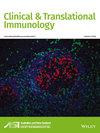Long-lasting changes in circulating dendritic cell and monocyte subsets, and altered expression of EMR2, CD97 and EMR3 on these cells in the posttraumatic course
Abstract
Objectives
Traumatic injury triggers the rapid release of damage-associated patterns (DAMPs). Dendritic cells (DCs) and monocytes play key roles in sensing, processing, and presenting DAMPs to naïve T cells. These heterogeneous immune cells express the adhesion GPCR EMR2/ADGRE2, which is likely regulated by DAMPs.
Methods
We analysed the various blood DC and monocyte subsets in trauma patients and uninjured volunteers using flow cytometry. EMR2 and its closest relatives, CD97/ADGRE5 and EMR3/ADGRE3, were quantified on these subsets to gain insights into their (patho)physiological regulation.
Results
Following trauma, conventional and plasmocytoid DCs nearly disappeared from the circulation, which is inversely correlated with injury severity and adverse clinical parameters 120–240 h post injury. Alterations in EMR2 and CD97 on DCs were relatively minor. Classical monocytes increased, while non-classical monocytes showed a sustained decline in both absolute number and percentage, in a manner dependent on injury severity after trauma. EMR2 expression increased across all monocyte subsets, whereas CD97 showed little change. EMR3 expression decreased and remained low in classical monocytes, while it markedly increased in non-classical monocytes. These temporal patterns in adhesion GPRC expression were largely independent of injury severity and were observed in all injured patients.
Conclusion
Circulating DC and monocyte subsets underwent significant compositional changes after trauma, often correlating with injury severity and other clinical parameters. Despite structural similarities, EMR2, CD97, and EMR3 showed distinct regulatory patterns on monocyte subsets, suggesting different functional roles in the immune response to injury.


 求助内容:
求助内容: 应助结果提醒方式:
应助结果提醒方式:


